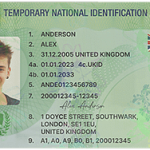Understanding Real ID: A Foundation for Modern Security
In an era where digital and physical threats intersect, reliable identity verification has become a cornerstone of public safety. At the heart of this effort lies the Real ID Act, a federal legislation enacted in 2005 following recommendations from the 9/11 Commission. Unlike standard driver’s licenses, Real ID-compliant credentials are designed to meet strict security criteria, creating a uniform framework for verifying who individuals claim to be. This framework directly supports homeland security by reducing vulnerabilities in systems that could be exploited by malicious actors.
Key Features of Real ID
Real ID is not merely a rebranded driver’s license; it incorporates specific technical and procedural safeguards. To obtain one, applicants must provide documented proof of identity (e.g., birth certificate or passport), social security number, and two forms of residency verification. States issuing these IDs must store data in secure systems, use tamper-resistant materials, and include features like holographic overlays, machine-readable zones, and unique identifiers. These elements make counterfeiting or altering the ID significantly more difficult, ensuring that each credential corresponds to a verified individual.
Homeland Security Objectives: A Focus on Prevention and Protection
Homeland Security’s mission centers on four primary goals: preventing terrorism and enhancing security, securing and managing U.S. borders, enforcing and administering immigration laws, and safeguarding and securing cyberspace. Each of these objectives relies on accurate identity verification to function effectively. For example, preventing terrorism requires knowing who has access to critical infrastructure, while securing borders depends on distinguishing authorized travelers from those attempting to enter illegally.
How Real ID Directly Supports Homeland Security Goals
1. Strengthening Access Control to Sensitive Areas
Federal regulations mandate that Real ID is required for accessing certain secure facilities, including military bases, nuclear power plants, and federal courthouses. Before Real ID, inconsistent state ID standards meant an individual could use a forged or stolen license to gain entry to these locations. By standardizing ID requirements, Real ID ensures that only verified individuals can pass through security checkpoints, reducing the risk of insider threats or targeted attacks.
2. Enhancing Aviation Security
Since 2020, the Transportation Security Administration (TSA) has required Real ID for domestic air travel. This policy addresses a critical vulnerability identified post-9/11: terrorists using fraudulent IDs to board planes. With Real ID, TSA agents can more quickly and accurately verify a passenger’s identity, streamlining the screening process while preventing unauthorized individuals from accessing aircraft.
3. Improving Border and Immigration Enforcement
Real ID plays a role in distinguishing lawful residents from those in the country illegally. When paired with systems like the U.S. Visitor and Immigrant Status Indicator Technology (US-VISIT), Real ID helps border patrol agents confirm an individual’s legal status. For example, a non-citizen presenting a Real ID must have provided documentation proving their right to reside in the U.S., making it harder for unauthorized individuals to use fake IDs to obtain employment or services.
4. Supporting Emergency Response Coordination
During natural disasters or other emergencies, first responders need to quickly identify affected individuals to provide aid, reunite families, or verify eligibility for disaster relief. Real ID’s standardized format and secure data storage allow agencies like FEMA to cross-reference IDs with national databases, ensuring resources reach those who need them most without delay.
Implementation Challenges and Solutions
Adopting Real ID was not without hurdles. Initially, many states faced logistical challenges, including upgrading ID-issuance systems, training staff, and educating the public. Privacy concerns also arose, as collecting additional personal data raised questions about how information would be protected. To address these issues, the Department of Homeland Security (DHS) provided grants for technology upgrades and established strict guidelines for data storage, including encryption and limited access. Public awareness campaigns, such as state-led workshops and online resources, helped clarify that Real ID data is used only for verification purposes and not shared without consent.
Common Questions About Real ID and Homeland Security
1. What happens if I don’t have a Real ID?
If you don’t have a Real ID, you can still use other federally accepted forms of identification, such as a U.S. passport, military ID, or Global Entry card, for domestic air travel or accessing federal facilities. However, using these alternatives may require additional preparation, such as ensuring your passport is not expired.
2. Does Real ID replace a standard driver’s license?
No, Real ID is an optional upgrade. States continue to issue non-Real ID driver’s licenses, but these cannot be used for federal purposes after the compliance deadline (currently May 7, 2025). Individuals who do not need to access federal facilities or board domestic flights may choose to keep their standard license.
3. How does Real ID protect against identity theft?
Real ID’s security features (e.g., holograms, unique identifiers) make it harder to counterfeit. Additionally, states are required to store applicant data securely, reducing the risk of breaches. However, Real ID does not eliminate identity theft entirely; individuals should still protect their personal information (e.g., social security numbers) from exposure.
4. Are all states compliant with Real ID?
As of 2023, all 50 states and U.S. territories issue Real ID-compliant credentials, though some may offer non-compliant options. DHS maintains a list of compliant states on its website, which is updated as policies change.
5. Can Real ID be used to track individuals?
No. Real ID does not include GPS or tracking technology. The data stored by states is used only for verification purposes, such as confirming identity during TSA checks or facility access. Federal laws, including the Privacy Act of 1974, restrict how this information can be shared or used.


